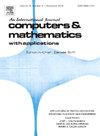U-WNO:用于求解参数偏微分方程的U-Net增强小波神经算子
IF 2.5
2区 数学
Q1 MATHEMATICS, APPLIED
引用次数: 0
摘要
高频特征在湍流和相变等多尺度现象中是至关重要的,因为它们编码了基本的物理信息。最近提出的小波神经算子(WNO)利用小波的时频定位来有效捕获空间流形。其因式分解策略虽然提高了噪声的鲁棒性,但也存在有限尺度小波分解带来的高频信息损失。本文提出了一种新的U-WNO网络架构。在小波层中引入U-Net路径和残差捷径,增强了高频特征的提取,提高了空间流形的学习能力。此外,我们引入了一种自适应激活机制,通过可训练的斜率参数来减轻光谱偏差。对七个PDE系列(Burgers、Darcy flow、Navier-Stokes等)的广泛基准测试表明,与基线WNO相比,U-WNO实现了45-83%的误差减少,平均L2相对误差范围为0.043%至1.56%。该架构建立了一个将多分辨率分析与深度特征学习相结合的框架,解决了算子学习中频谱与空间的权衡问题。使用的代码和数据可在https://github.com/WeiminLei/U-WNO.git上获得。本文章由计算机程序翻译,如有差异,请以英文原文为准。
U-WNO: U-Net enhanced wavelet neural operator for solving parametric partial differential equations
High-frequency features are critical in multiscale phenomena such as turbulent flows and phase transitions, since they encode essential physical information. The recently proposed Wavelet Neural Operator (WNO) utilizes wavelets' time-frequency localization to capture spatial manifolds effectively. While its factorization strategy improves noise robustness, it suffers from high-frequency information loss caused by finite-scale wavelet decomposition. In this study, a new U-WNO network architecture is proposed. It incorporates the U-Net path and residual shortcut into the wavelet layer to enhance the extraction of high-frequency features and improve the learning of spatial manifolds. Furthermore, we introduce an adaptive activation mechanism to mitigate spectral bias through trainable slope parameters. Extensive benchmarks across seven PDE families (Burgers, Darcy flow, Navier-Stokes, etc.) show that U-WNO achieves 45–83% error reduction compared to baseline WNO, with mean relative errors ranging from 0.043% to 1.56%. This architecture establishes a framework combining multiresolution analysis with deep feature learning, addressing the spectral-spatial tradeoff in operator learning. Code and data used are available on https://github.com/WeiminLei/U-WNO.git.
求助全文
通过发布文献求助,成功后即可免费获取论文全文。
去求助
来源期刊

Computers & Mathematics with Applications
工程技术-计算机:跨学科应用
CiteScore
5.10
自引率
10.30%
发文量
396
审稿时长
9.9 weeks
期刊介绍:
Computers & Mathematics with Applications provides a medium of exchange for those engaged in fields contributing to building successful simulations for science and engineering using Partial Differential Equations (PDEs).
 求助内容:
求助内容: 应助结果提醒方式:
应助结果提醒方式:


